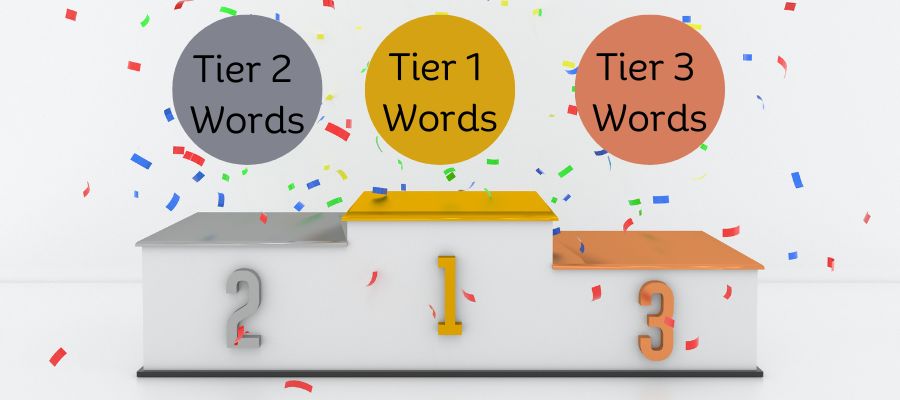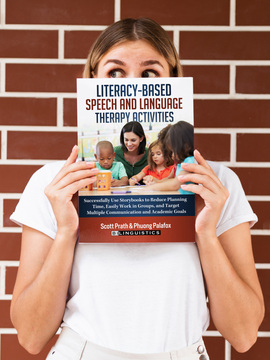After a couple of years of being an SLP, I was blown away by the sheer intelligence being demonstrated on a daily basis in my daughter’s daycare center. Wow! These kids were geniuses!! Just learning and speaking without any help from adults…
It dawned on me that by spending 40-50 hours each week with children with communication impairments, I forgot how the other 90% of children develop. Alas, my daughter was just typical. (Sorry if you are reading this, my dear child).
I think we special educators need to be reminded of the elegance, speed, and beauty that accompanies typical learning. It’s especially true with vocabulary as we work with children who fight tooth-and-nail to acquire a fraction of the word wall that their peers do. Yes, our students need support. But, by seeing what’s possible we are reminded to keep the bar raised and work towards the highest potential.
In this essay I want to share the three tiers that vocabulary learning is divided across. It paints a picture of where we can intervene to have the greatest impact. I end with a comparison of second language vocabulary use versus disordered use as that can cause us some of the greatest confusion when we are trying to make a diagnosis.

Typical Vocabulary Acquisition
Let’s take a look at typical development because this is mind-blowing. Typically most first grade students have a vocabulary of 6,000 words, and then they learn 3000 words a year until third grade. That’s just bananas, isn’t it? So yes, they’re educated. But think of that rate of acquisition in comparison to some of our guys on our caseloads and fighting for handfuls of words.
And how does this happen? Vocabulary specialists have divided acquisition into three tiers. Tier one includes all basic words. Tier two includes high-frequency words and multiple-meaning words, and tier three words are subject related.

Tier 1 Vocabulary Words
Tier one includes words like nouns, verbs, and adjectives. These are words from sight-reading from the lower reading levels at the kindergarten and first grade level. These words rarely require direct instruction because they are common and don’t have multiple meanings. This is also the first vocabulary we see develop when a child is learning English.

Tier 2 Vocabulary Words
When we talk about tier two words, these are high frequency words that occur in mature language situations like adult conversations and reading. The easiest way to think about it is the difference between our receptive vocabulary and our expressive vocabulary. All the words you understand from all your fancy books that you read, versus the words you would actually use on a daily basis or words you would write or type into email. Ultimately, these words are extremely important for reading comprehension.
Tier two words can have multiple meanings and they can be used in different environments. Whereas basic words pretty much stick to one definition. Direct instruction is needed to learn these words because a person who is not in an educational setting or trying to improve their language abilities wouldn’t learn how to use them through natural conversation.

Tier 3 Vocabulary Words
At the top, we have tier three words which are really low frequency words. For example, these might include topics like occupational concepts, geography, or technology. We learn them only as the need arises or interest is high.
For example, I was working with a little guy who was crazy about planets. He had an incredible science vocabulary that far exceeded my own. So in our sessions, he was actually teaching me!
Where to Intervene to Increase Vocabulary
Here is where this research really hits home. If a child is in special education, chances are that they may not have the 6,000 spoken words and are probably not learning 3000 words a year until third grade. You can see how this is so problematic as the grade level demands increase so quickly as they get older.
As special educators it benefits us to think about the words that we are using in our lessons and what tiers they would most likely fall in. They produce these quick rules for us to follow:
Vocabulary Teaching Rules for SLPs
- Include as many tier one, foundational words that we can in any lesson.
- Teach tier one words directly.
- High frequency and multiple meaning words (tier 2) need to be taught in context. The best way to go about this is by using narratives during intervention and video examples.
- Low frequency words (Tier 3) should only be targeted if they are part of the student’s curriculum and the student has a way to practice and use these words outside of your session.
Differences Between Vocabulary Difficulties and Second Language Acquisition
Lastly, let’s clear up some of the confusion between low vocabulary issues and children who are learning English as a second language. The confusion makes sense, right? Both groups have vocabulary development that is not typical. However, there are stark differences between vocabulary difficulties and second language acquisition. Below are two rough lists. We have two things going on: Vocabulary development that looks different when a child is under the huge demand of learning two languages. Vocabulary development that is diminished for no apparent reason.
Additionally, what I think these two lists tell us is why we have so many children that are referred for special education who might have a second language at home. We need to consider them for services, but not necessarily qualify them.
In both groups we would expect to see reduced utterance length. But after that, what we see is that a child who has not learned enough English to support the conversation is still really working at it. He’s describing, choosing similar things he does know the name of, or maybe substituting foreign vocabulary if he knows the word in his home language. A child with a disorder also does not look like his peers. But, he could abandon utterances, use sound effects, use non-content words, and generally need a lot of questioning to get his point across.

Also, check out this essay: A Breakdown of Vocabulary Research as it Pertains to SLPS




